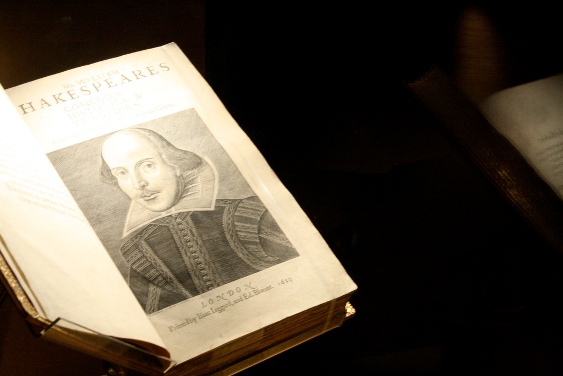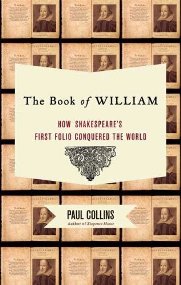
The Book of William: How Shakespeare’s First Folio Conquered the World
by Paul Collins
–Reviewed by Jodie Liu
 On July 13, 2006, Sotheby’s in London made headlines with a $5.3 million dollar sale. The amount alone wasn’t unusual; works by famed painters often surpass the figure. What made the auction remarkable was that the item on sale wasn’t a painting. The highest bidder Simon Finch purchased a book – one of the last remaining copies of Shakespeare’s First Folio. And in fact, it wasn’t even the highest price ever paid for a First Folio – Microsoft’s Paul Allen shelled out $6.1 million at Christie’s.
On July 13, 2006, Sotheby’s in London made headlines with a $5.3 million dollar sale. The amount alone wasn’t unusual; works by famed painters often surpass the figure. What made the auction remarkable was that the item on sale wasn’t a painting. The highest bidder Simon Finch purchased a book – one of the last remaining copies of Shakespeare’s First Folio. And in fact, it wasn’t even the highest price ever paid for a First Folio – Microsoft’s Paul Allen shelled out $6.1 million at Christie’s.
Of course, the First Folio is more than a book. Both men had claimed what Paul Collins calls in his The Book of William “the most scrutinized book edition in the history of the English language.”
Published in 1623, Shakespeare’s First Folio had no oversight from Shakespeare himself – the bard died seven years earlier, without ever having sought to publish his plays. Instead, the tremendous undertaking of compiling all of Shakespeare’s known works began after his death by two of his closest friends, the aging actors John Heminge and Henry Condell. Only a thousand or so copies were originally made, but this handful of First Folios made Shakespeare the single most influential author in history – without the Folio, he might well have been an arcane British playwright. In The Book of William, the title a not-so-subtle nod to the near-biblical universality of Shakespeare, Collins provides a richly-detailed history of the First Folio in true Shakespearian form: five acts.
The curtain rises with Sotheby’s auction room set ablaze by the “slow burn of old books” and falls in the Shinjuku district of Tokyo. Collins compiles intriguing anecdotes about historical figures whose hand-me-down treatment of the First Folio complemented, and indeed made possible, Shakespeare’s rise to international posthumous fame. To take one example, Collins points out that Alexander Pope’s greatest contribution to Shakespearean scholarship was his awful edition of Shakespeare – it prompted Pope’s nemesis Lewis Theobald to pull out his copy of the First Folio and expose Pope’s many mistakes. In the process, Theobald published portions of The History of Cardenio, a Shakespeare play that was previously thought to be lost entirely. Though today the play exists only in a greatly rewritten form, the original versions having disappeared when Theobald died, Theobald’s copy of the First Folio was snatched up by Samuel Johnson. Johnson worked with friend and actor David Garrick to make Shakespeare “a national saint-and the First Folio his one true book.”
Between the passing of the Folio between Theobald and Johnson, Collins notes, Shakespeare became accessible to scholars and the masses, not just select bibliophiles. As it turns out, Theobald’s publisher Jacob Tonson raced against smaller renegade presses to see who could churn out as many copies of Shakespeare for as cheap as possible. Though the Folio continued to be prized, thousands of copies of Shakespeare’s plays hit bookstore shelves and sold for pennies apiece.
Collins goes on to examine how Shakespeare’s influence has spread beyond England and the English-speaking world. After learning that most “obsessive modern collectors” of the First Folio actually come from Japan, Collins heads to Tokyo, where he witnesses writers and artists who are “hungry and ambitious to make Shakespeare’s work their own.” With copies of the First Folio in hand, these artists have put their own stamp on Shakespeare. Fans can now pore over Heavy Metal Macbeth, buy Shakespeare karuta playing cards, and flip through a manga version of Hamlet that is “prolific, exuberant, crude, and often derivative, but punctuated by startling moments of brilliance-just as Elizabethan theater once was.”
Considering all the dedicated Shakespearean scholarship, it seems cruel that we will never be able to recover certain elements of Shakespeare. Collins jokingly speculates that one of the original compositors of the First Folio must have been a “butterfingered” 17-year-old apprentice, for in King Lear, France may either be “hot-blooded” or “hot-bloodied.” Machines like the Hinman device have been designed to identify and compare such variations in the text, Collins explains. But even now, when book scholarship is becoming increasingly meticulous, no amount of technology can make up for mistakes made when bookmaking was far less precise a science.
It’s still a small price to pay for what Sotheby’s Peter Selley calls “the most important work in English literature, and indeed the most important secular work of all time.” And perhaps some room for interpretation is a good thing, Collins suggests. If the history of the First Folio is any indication, it is what keeps us coming back to Shakespeare.
Excerpt: “What set Shakespeare apart from virtually every other playwright, Smauel Johnson pointed out, was that his plays were not about love. True, love was a fine thing – ‘But love is only one of many passions; and as it has no great influence upon the sum of life, it has little operation in the dramas of a poet who caught his ideas from the living world and exhibited only what he saw before him.’ And true to the world, heroes were difficult to discern in these plays. ‘Shakespeare has no heroes,’ Johnson pronounced, ‘his scenes are occupied only by men.’ These two elements – a love plot and a central hero – were the veritable oxygen and gravity in the worlds that most playwrights inhabited. But that was not Shakespeare’s world His world was our world – and this, Johnson implied, was why Shakespeare had taken his place among the world’s greatest writers.”
Further Reading: So Long as Men Can Breathe: The Untold Story of Shakespeare’s Sonnets and Soul of the Age: A Biography of the Mind of William Shakespeare
*Photo courtesy expatriotact.




Send A Letter To the Editors